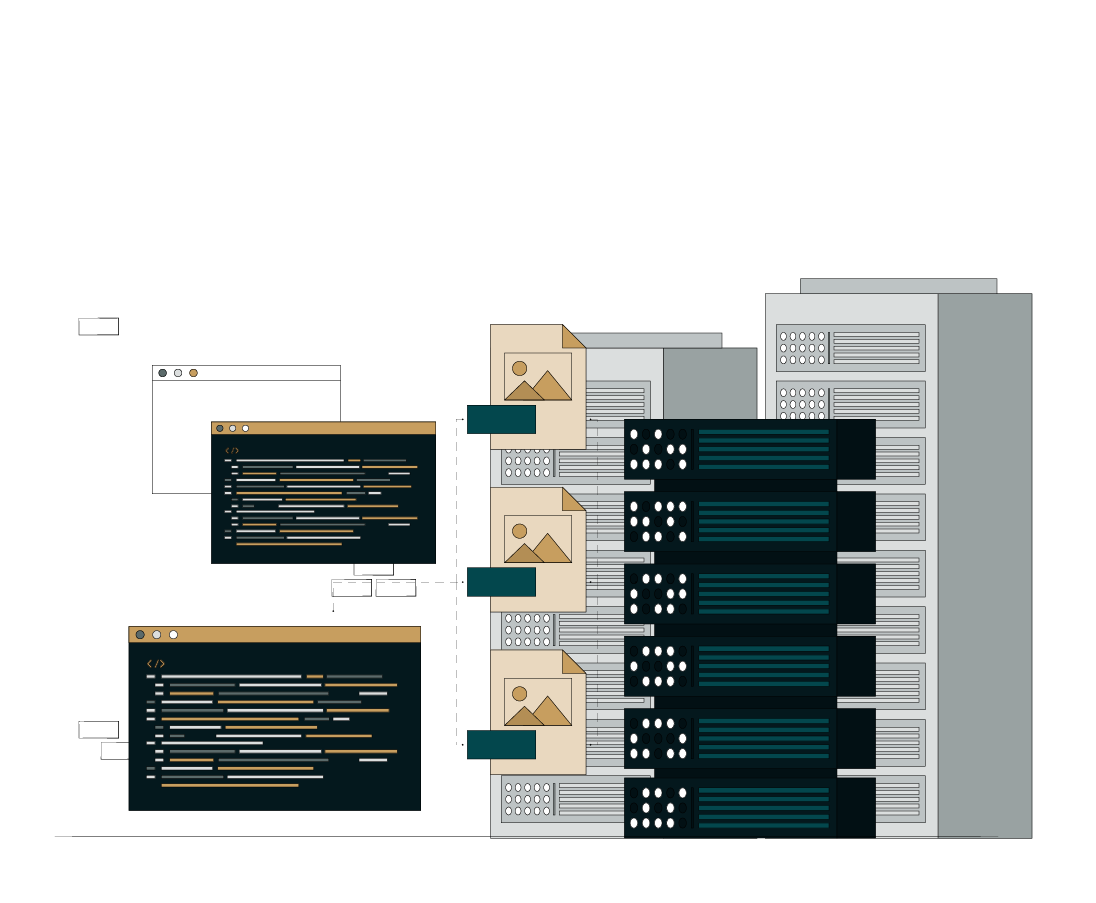Galloping Through Scalable Backend Glory with Node.js as the Unbridled Stallion of Technological Mastery
With regards to server-side programming, the Node.js backend resembles a guide having a virtuoso influence, orchestrating an amicable ensemble of speed, effectiveness, and versatility, with each line of code being a significant note. This blog offers you an opportunity to dive into the delightfully designed universe of “Node.js: Powering Scalable Backend Solutions with Ease.” With its strong JavaScript and event-driven design, creating a backend with Node.js gets through the traditional backend development paradigms. It is something beyond a runtime environment; a progressive power empowers developers to make versatile and responsive applications easily. Through exploring the universes of offbeat operations and non-blocking I/O, this examination uncovers Node.js’ innate beauty. An idea saturates the passages of effective, real-time applications instead of simply a technology.
Through exploring the universes of offbeat operations and non-blocking I/O, this examination uncovers Node.js’ innate beauty. An idea saturates the passages of effective, real-time applications instead of simply a technology.
This blog guarantees a journey beyond the usual, whether you’re a seasoned developer looking for an adaptable backend solution or a novice drawn to Node.js for backend development. Get ready to be spellbound by the stories of impeccable versatility, as Node.js flaunts its ability to deal with several connections immediately. Node.js’ allure is universal, attracting both startups and established IT companies alike with its simplified approach to backend solutions that fit in with the beat of contemporary development. Node.js is a maestro in the realm of backend orchestration, where each byte matters. It effortlessly and elegantly leads an ensemble of versatility. Come explore the dexterity of Node.js with us as we investigate how efficiency and innovation consolidate to transcend the mundane.
A Pensive Appraisal of the Relevance of Node.js for backend development
The applicability of Node.js, a potent runtime climate for backend programming that has obtained huge ubiquity, is subject to several factors. It performs exceptionally well in situations requiring adaptable, event-driven, real-time applications. Node.js for backend development is something to ponder when extraordinary performance and quick development are top contemplations. A huge advantage of Node.js is its asynchronous, non-blocking I/O mechanism, which works with the effective management of several concurrent connections. Applications that call for real-time functionality, such as chat programs, online games, or collaboration tools, will particularly profit from this. Besides, Node.js utilizes JavaScript, which makes full-stack development conceivable with a single language and codebase. This can further develop code reuse, accelerate development, and make maintenance easier. Node.js’ lightweight design and simple horizontal scaling make it an incredible decision for microservices architecture. Its smooth incorporation with containerization technologies, for example, Docker, makes deployment and versatility easier.
Besides, a large number of pre-built modules and packages are accessible through the flourishing npm ecosystem, which speeds up development processes. A problem-solving methodology driven by the community is encouraged by this diverse ecology. Be that as it may, as a result of its single-threaded event loop, which can turn into a bottleneck, backend development using Node.js probably won’t be the most ideal choice for CPU-intensive jobs or applications requiring a ton of calculation. Other languages might do better in these circumstances. Backend developers ought to consider using Node.js when scalability, real-time capabilities, and rapid development are basic prerequisites. This is especially valid for frameworks requiring high concurrency or microservices.
Adorning Your Business in the Finery of Node.js or its Cognates
Node.js is a JavaScript runtime that challenges existing server-side technologies in the backend development space. It is based on the top of Chrome’s V8 engine. It is vital to evaluate the benefits and disadvantages of Node.js in contrast with other backend technologies while pondering them for your organization. The event-driven, non-blocking architecture of the Node.js backend is applauded for taking into consideration high concurrency and adaptability. It is ideal for online gaming, streaming services, and chat apps since it performs well in real-time applications. Since JavaScript is a single language, developers can utilize it for both frontend and backend development, which promotes code reuse and teamwork. Then again, more established backend technologies with strong ecosystems, including Java, Python, and Ruby, are more established. For instance, enterprise-level applications can profit from Java’s robust multithreading capacities.  Python is a famous decision for data-driven applications because of its flexibility and readability, though Ruby on Rails offers a convention over configuration (CoC) move that streamlines development.
Python is a famous decision for data-driven applications because of its flexibility and readability, though Ruby on Rails offers a convention over configuration (CoC) move that streamlines development.
The requirements of the project decide the backend technology— Node.js or another — to utilize. Backend development with Node.js functions admirably in circumstances demanding real-time communication; at the same time, for complex, computation-intensive jobs, Java and Python may be more fitting. Even though Node.js is viable at concurrent connections, scalability, and adaptability likewise become an integral factor. Nonetheless, Java’s multithreading powers come into play in resource-intensive applications. Also, current developer expertise should be considered. While teams with experience with Python or JavaScript might be inclined toward their respective ecosystems, teams with experience with Node.js might find that it simplifies development. The choice at last boils down to the points of interest of your project, the requests for adaptability, and the mastery of your development team. Each technology has advantages and disadvantages, and a careful analysis ensures your backend will work together as one with your organization’s objectives.
Node.js Emerges as the Definitive Cynosure in the Realm of Backend Development
Node.js is the best framework for backend programming, and its ascent to popularity might be credited to several factors. One of its key advantages is its event-driven, non-blocking architecture, which makes it conceivable to at the same time deal with multiple connections. Traditional backend solutions frequently have adaptability issues since they are synchronous. Then again, the Node.js backend is ideal for real-time applications since it can deal with various solicitations at once. Another intriguing aspect is the utilization of JavaScript in both frontend and backend development. This unification streamlines the development process by empowering developers to work with a single language across the stack. This prompts better code consistency, simpler upkeep, and more effective communication between frontend and backend teams. The backend for Node.js is based on top of the V8 JavaScript engine, which is notable for its extraordinary speed and performance. Node.js is the ideal choice for applications that need high throughput and low latency on account of its faster code execution. This performance support is particularly required for programs like gaming platforms, chat apps, and live-streaming services.
A significant assortment of open-source libraries is likewise accessible through Node Package Management (NPM), the package manager for Node.js. Owing to this vast ecosystem, developers can take advantage of pre-built modules and assist development by staying away from the need to compose all the code from scratch. It guarantees that developers have simple admittance to a heap of tools, guidelines, and patches by the dynamic and supportive Node.js community. Besides, Node.js’ lightweight and minimalist design philosophy makes it versatile for an assortment of use scenarios. Empowering the development of microservices can make huge-scope programs more adaptable and maintained due to their modular architecture. Backend development with Node.js is an extraordinary choice given its astonishing performance, extensive package ecosystem, adaptability, and unification of JavaScript. These qualities go with web development, a superb decision for creating adaptable, high-performing, and real-time applications in the constantly developing area.
The Balletic Synchronization of NodeJS in the Real-Time Orchestration of Netflix
Real-time applications depend heavily on backend development using Node.js, a server-side JavaScript runtime, in light of its non-blocking, event-driven architecture. Node.js is a force to be reckoned with in the realm of streaming services like Netflix, where clients anticipate smooth and quick updates. Generally, Node.js utilizes a single-threaded event loop that effectively handles several connections at once. On account of Netflix, this infers that Node.js processes user-initiated requests, such as playing a video or navigating the interface, asynchronously to keep away from bottlenecks and guarantee responsiveness. While watching videos, Netflix’s real-time application abilities are illustrated. At the point when clients need to fast-forward, rewind, or change settings, Node.js handles these solicitations without causing a break to empower seamless transitions.  In light of the event-driven architecture design, clients are more fulfilled overall because different users can keep on streaming content as one user engages with the site.
In light of the event-driven architecture design, clients are more fulfilled overall because different users can keep on streaming content as one user engages with the site.
Besides, Node.js and WebSocket technologies join flawlessly to take into account bidirectional client-server communication. This truly intends that, about Netflix, changes to a client’s review history, inclinations, or recommendations can be immediately reflected in the UI, bringing about a dynamic and customized streaming experience. Besides, Node.js is phenomenal at dealing with a ton of connections on the double, which is fundamental for a platform like Netflix that upholds a huge number of users at once. Create a backend with node js as it is the most ideal choice for real-time applications with a scope of responsibilities because of its versatility and lightweight design. Node.js revolutionizes how we engage with real-time apps, and the fact that Netflix and other industry giants have taken on it verifies its adequacy in producing quick, responsive, and engaging user experiences. Node.js will be a central part of deciding the direction of real-time apps as we keep on anticipating instantaneous experiences in the digital world.
Pattem Digital’s Node.js Development Services in a Class of Their Own
Our Node.js development company makes custom solutions that blow away expectations, making it an unrivaled guide of brightness in the brilliance in the fast-paced world of digital innovation. Our seasoned developers orchestrate smooth, versatile, and innovative applications with an ensemble of state-of-the-art skills, precisely consolidating prowess. We travel through the computerized world with grace, deftly dealing with the intricacies of Node.js to take our clients to new heights of unmatched achievement. Our creations, which range from sophisticated real-time apps to sturdy server-side development, change the idea of user experience. Select us and transcend the norm, where our unparalleled Node.js services accompany an intrinsic nature of significance rather than as an aim.





